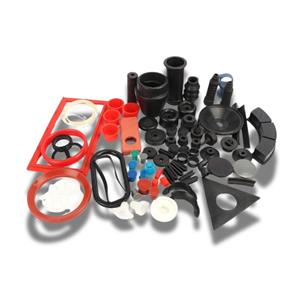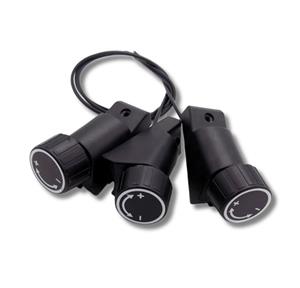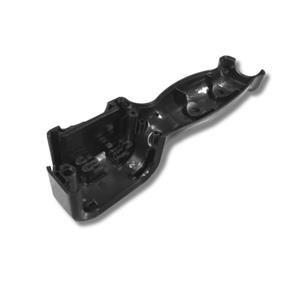Injection mold composition
Although the structure of the mold may vary due to different types and properties of plastics, shapes and structures of plastic products, and types of injection machines, the basic structure is the same. The mold is mainly composed of pouring system, temperature control system, molded parts and structural parts. Among them, the pouring system and molded parts are the parts that are in direct contact with plastics and change with the plastics and products. They are the most complex and changing parts of the mold and require the highest processing smoothness and precision.
The injection mold consists of two parts: a movable mold and a fixed mold. The movable mold is installed on the movable template of the injection molding machine, and the fixed mold is installed on the fixed template of the injection molding machine. During injection molding, the movable mold and the fixed mold are closed to form the pouring system and cavity. When the mold is opened, the movable mold and the fixed mold are separated to facilitate removal of plastic products. In order to reduce the heavy workload of mold design and manufacturing, most injection molds use standard mold bases.
Gating system
The gating system refers to the runner part before the plastic enters the cavity from the nozzle, including the main channel, cold material cavity, runner and gate, etc.
The gating system is also called the runner system. It is a set of feed channels that guide the plastic melt from the injection machine nozzle to the mold cavity. It usually consists of a main channel, a runner, a gate and a cold material cavity. It is directly related to the molding quality and production efficiency of plastic products.
main channel
It is a passage in the mold that connects the nozzle of the injection molding machine to the runner or cavity. The top of the main flow channel is concave to connect with the nozzle. The diameter of the main channel inlet should be slightly larger than the diameter of the nozzle (0.8mm) to avoid overflow and to prevent the two from being blocked due to inaccurate connection. The inlet diameter depends on the size of the product, generally 4-8mm. The main channel diameter should be expanded inward at an angle of 3° to 5° to facilitate the demoulding of the runner excess.
cold material hole
It is a cavity located at the end of the main channel to capture the cold material generated between two injections at the end of the nozzle, thereby preventing the runner or gate from being blocked. If cold material is mixed into the mold cavity, internal stress will easily occur in the manufactured product. The diameter of the cold material cavity is about 8-10mm and the depth is 6mm. In order to facilitate demoulding, the bottom is often borne by a demoulding rod. The top of the demoulding rod should be designed in a zigzag hook shape or have a sunken groove so that the main channel debris can be pulled out smoothly during demoulding.
shunt
It is the channel connecting the main channel and each cavity in the multi-slot mold. In order for the molten material to fill each cavity at a constant speed, the runner arrangement on the mold should be symmetrical and equidistantly distributed. The shape and size of the runner cross section have an impact on the flow of plastic melt, product demoulding and the ease of mold manufacturing. If we consider the flow of equal amounts of material, the flow channel with circular cross-section has the smallest resistance. However, because the specific surface of the cylindrical runner is small, it is unfavorable for the cooling of the runner extensions, and the runner must be opened on the two halves of the mold, which is labor-intensive and difficult to align. Therefore, a trapezoidal or semicircular cross-section runner is often used, and is opened on half of the mold with a demoulding rod. The runner surface must be polished to reduce flow resistance and provide faster mold filling speed. The size of the runner depends on the type of plastic, the size and thickness of the product. For most thermoplastics, the cross-sectional width of the shunt is no more than 8m, the extra large can reach 10-12m, and the extra small can reach 2-3m. On the premise of meeting the needs, the cross-sectional area should be reduced as much as possible to increase the redundancy of the shunt and extend the cooling time.
Gate
It is the channel that connects the main channel (or runner) and the cavity. The cross-sectional area of the channel can be equal to the main channel (or branch channel), but it is usually reduced. So it is the part with the smallest cross-sectional area in the entire flow channel system. The shape and size of the gate have a great influence on the quality of the product.
The function of the gate is:
A. Control material flow speed:
B. During injection, the melt stored in this part can be prevented from flowing back due to early solidification:
C. Subject the passing melt to strong shear to increase the temperature, thereby reducing the apparent viscosity to improve fluidity:
D. Facilitate the separation of products and flow channel system. The design of gate shape, size and location depends on the nature of the plastic, the size and structure of the product. Generally, the cross-sectional shape of the gate is rectangular or circular, and the cross-sectional area should be small and the length should be short. This is not only based on the above effects, but also because it is easier for a small gate to become larger, but it is difficult to reduce a large gate. The gate position should generally be selected where the product is thickest without affecting the appearance. The gate size should be designed taking into account the properties of the plastic melt. The cavity is the space in the mold where plastic products are formed. The components used to form the cavity are collectively called molded parts. Individual molded parts often have special names. The molded parts that constitute the appearance of the product are called concave molds (also called female molds), which constitute the internal shape of the product.
(such as holes, slots, etc.) are called cores or punches (also called male molds). When designing molded parts, the overall structure of the cavity must first be determined based on the properties of the plastic, the geometry of the product, dimensional tolerances and usage requirements. The second step is to select the location of the parting surface, gates and vents as well as the demoulding method according to the determined structure. Finally, the parts are designed according to the size of the control product and the combination of the parts is determined. The plastic melt has high pressure when entering the mold cavity, so the molded parts must be reasonably selected and their strength and stiffness checked. In order to ensure that the surface of plastic products is smooth, beautiful and easy to demould, all surfaces in contact with plastics must have a roughness Ra>0.32um and must be corrosion-resistant. Formed parts are generally heat treated to increase hardness and made of corrosion-resistant steel.
Temperature control system
In order to meet the mold temperature requirements of the injection process, a temperature adjustment system is required to adjust the temperature of the mold. For injection molds for thermoplastic plastics, the cooling system is mainly designed to cool the mold. The common way to cool the mold is to open a cooling water channel in the mold, and use the circulating cooling water to take away the heat of the mold; in addition to using hot water or steam in the cooling water channel, the heating of the mold can also be done by installing electricity inside and around the mold. Heating element.
Molded parts
Molding parts refer to various parts that constitute the shape of the product, including movable molds, fixed molds and cavities, cores, forming rods and exhaust ports. The molded part consists of a core and a die. The core forms the inner surface of the product, and the die forms the outer surface shape of the product. After the mold is closed, the core and cavity form the cavity of the mold. According to the process and manufacturing requirements, sometimes the core and the die are composed of several pieces, sometimes they are made as a whole, and inserts are only used in parts that are easily damaged and difficult to process.
exhaust vent
It is a groove-shaped air outlet opened in the mold to discharge the original gas and the gas brought in by the melt. When the molten material is injected into the mold cavity, the air originally existing in the mold cavity and the gas brought in by the melt must be discharged out of the mold through the exhaust port at the end of the material flow. Otherwise, the product will have pores, poor connections, and The mold filling is not satisfactory, and the accumulated air may even burn the product due to high temperature caused by compression. Under normal circumstances, the exhaust hole can be located either at the end of the melt flow in the cavity or on the parting surface of the mold. The latter is to open a shallow groove with a depth of 0.03-0.2mm and a width of 1.5-6mm on one side of the die. During injection, a lot of molten material will not seep out of the vent hole, because the molten material will cool and solidify there and block the channel. The exhaust port must not be opened facing the operator to prevent the molten material from accidentally spraying out and injuring people. In addition, the matching gap between the ejector rod and the ejector hole, the matching gap between the ejector block and the stripping plate and the core can also be used to exhaust air.





